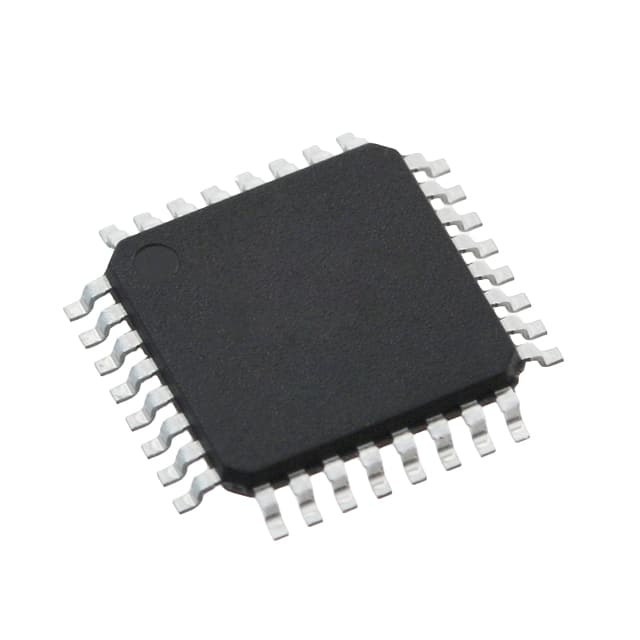Zie specificaties voor productdetails.

ATMEGA168PB-AU
Product Overview
The ATMEGA168PB-AU belongs to the category of microcontrollers and is widely used in various electronic applications. Known for its high performance and versatility, this microcontroller offers a wide range of characteristics and features. It comes in a compact package and is available in different packaging options with varying quantities.
Basic Information
- Category: Microcontroller
- Use: Electronic applications
- Characteristics: High performance, versatility
- Package: Compact
- Essence: Versatile microcontroller
- Packaging/Quantity: Various options available
Specifications
The ATMEGA168PB-AU features a 8-bit AVR microcontroller with advanced RISC architecture. It operates at a voltage range of 1.8V to 5.5V and offers a wide range of peripherals for different applications. The microcontroller has a flash memory of 16KB, EEPROM of 512 bytes, and SRAM of 1KB.
Detailed Pin Configuration
The detailed pin configuration of ATMEGA168PB-AU includes a total of 32 pins, each serving specific functions such as digital I/O, analog inputs, power supply, and communication interfaces. The pinout diagram provides a clear understanding of the connectivity and functionality of each pin.
Functional Features
The ATMEGA168PB-AU offers a multitude of functional features including multiple communication interfaces such as UART, SPI, and I2C, as well as analog-to-digital converters, timers, and PWM outputs. These features enable seamless integration into various electronic systems and facilitate efficient control and data processing.
Advantages and Disadvantages
Advantages: - High performance - Wide operating voltage range - Rich set of peripherals - Versatile communication interfaces
Disadvantages: - Limited memory capacity for certain applications - Higher power consumption compared to low-power microcontrollers
Working Principles
The working principle of ATMEGA168PB-AU revolves around its ability to execute instructions and process data based on the program stored in its flash memory. It interacts with external components through its various pins and peripherals, enabling the control and manipulation of connected devices.
Detailed Application Field Plans
The ATMEGA168PB-AU finds extensive application in diverse fields such as consumer electronics, industrial automation, embedded systems, and IoT devices. Its flexibility and feature-rich architecture make it suitable for applications requiring precise control, data processing, and communication.
Detailed and Complete Alternative Models
For those seeking alternatives to the ATMEGA168PB-AU, several other microcontrollers can be considered based on specific requirements. Some notable alternatives include the ATMEGA328P, PIC16F877A, STM32F103C8T6, and ESP32, each offering unique features and capabilities catering to different application needs.
In conclusion, the ATMEGA168PB-AU stands as a versatile and high-performance microcontroller with a wide range of applications and functionalities. Its rich set of features, along with its compatibility with various electronic systems, makes it a popular choice among developers and engineers across different industries.
Word Count: 443
Noem 10 veelgestelde vragen en antwoorden met betrekking tot de toepassing van ATMEGA168PB-AU in technische oplossingen
What is the ATMEGA168PB-AU?
- The ATMEGA168PB-AU is a high-performance, low-power 8-bit microcontroller based on the AVR enhanced RISC architecture.
What are the key features of the ATMEGA168PB-AU?
- Some key features include 16KB of in-system self-programmable flash memory, 1KB EEPROM, 2KB SRAM, 23 general-purpose I/O lines, and more.
What are the typical applications for the ATMEGA168PB-AU?
- It is commonly used in industrial automation, home and building control, IoT, motor control, and various other embedded control applications.
What are the communication interfaces supported by the ATMEGA168PB-AU?
- It supports USART, SPI, and TWI (I2C) communication interfaces.
What is the operating voltage range of the ATMEGA168PB-AU?
- The operating voltage range is 1.8V to 5.5V, making it suitable for a wide variety of applications.
Does the ATMEGA168PB-AU have built-in analog-to-digital converters (ADC)?
- Yes, it has a 10-bit ADC with up to 23 channels for analog input.
Can the ATMEGA168PB-AU be programmed using Arduino IDE?
- Yes, it can be programmed using the Arduino IDE with the appropriate board package and libraries.
What development tools are available for programming and debugging the ATMEGA168PB-AU?
- Development tools such as Atmel Studio, AVRDUDE, and various third-party programmers/debuggers can be used.
Are there any low-power modes available in the ATMEGA168PB-AU?
- Yes, it offers several low-power modes, including idle, ADC noise reduction, power-save, standby, and power-down modes.
What are the available package options for the ATMEGA168PB-AU?
- It is available in a 32-lead TQFP package, making it suitable for surface-mount applications.

